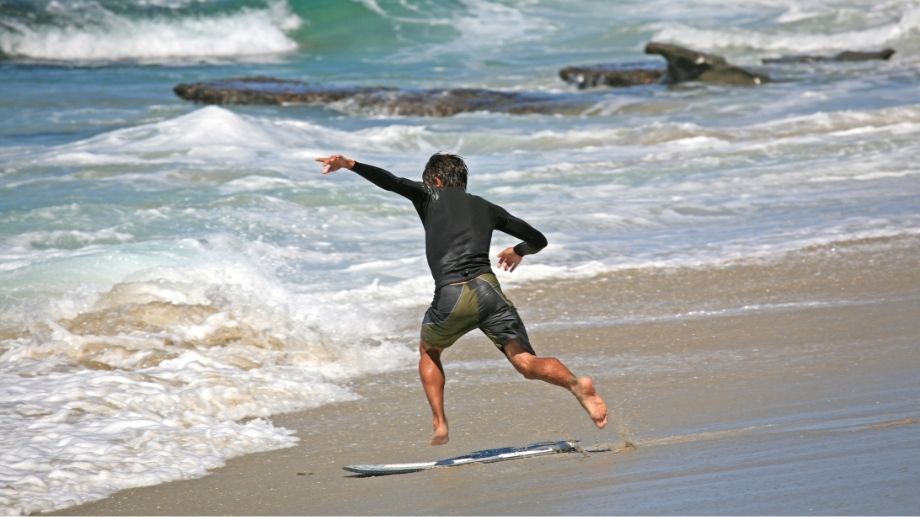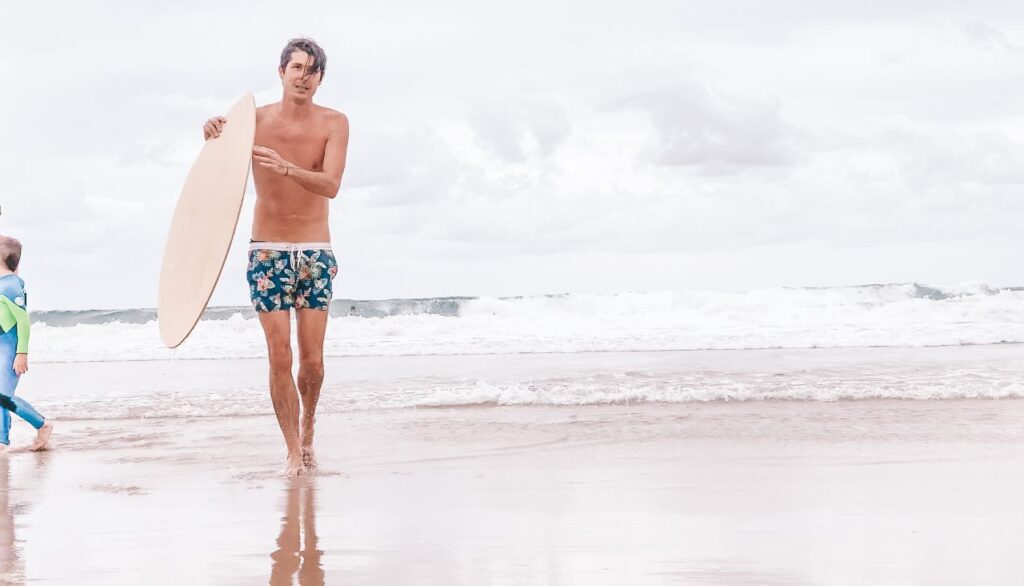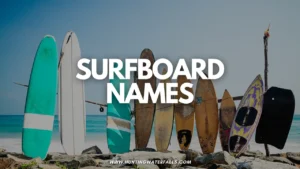Skimboards are like people. They come in all shapes and sizes and, like people and relationships, it is often difficult to find your perfect match.
With such a wide variety of different shapes, styles, lengths and thicknesses of skimboards on the market it can be difficult to know which skimboard is going to be best for your needs.
In this article we will walk you through the intricacies of how to choose the correct skimboard for your weight and height and skill level and look at a number of different skimboard designs so you can better understand which board will suit you best.
We will also talk about how the types of skimboarding as well as your level of performance will affect which board you should choose.
Perhaps you are a beginner and looking for an entry level board or maybe you have mastered the basics and are looking to take your performance and skills to the next level with a new board that will give you more skimming speed and the agility to do radical turns on waves.
You might even be looking at a first time board so you can try your hand at flatland skimming on a lake or inland waterway near you.
Check out our list of the best skimboards for beginners and choose the board that best suits you.
Skimming and Maneuverability

Even the smallest difference in skimboard shape and design can have a major impact on the performance of the board.
The majority of design decisions come down to:
- The speed and the distance you want to cover while skimming and/or
- How maneuverable the skimboard is on waves.
The basic rule of thumb is when you improve one you decrease the other.
Finding the right board for the right conditions can be tricky especially if you are new to the sport or are seeking to launch yourself into a higher level of skill and tricks.
Even people who are familiar with skimboards can sometimes get a bit muddled up with what is exactly the right size and shape of board for them.
It is important to remember that you don't need to be exact when it comes to measurements as most board manufactures make boards that fall into various size and weights ranges.
You will still get great performance out of a board that is close enough.
The Height Of The Skimboard Should Be Approximately Up To Your Sternum (Or Nipple Line)
A skimboard is basically an extension of your body so it's important to choose one with the correct proportions for your height.
Some people are longer in the legs while others have more length in the torso. The different ratio of torso to limbs affects your center of gravity so make sure you get this part correct as it is super important.
Grab a tape measure
The first thing to do is grab a tape measure and stand up straight.
Measure the distance from the ground to the middle of your chest at the height of your nipple line and take a note of the measurement.
This is approximately the correct size board for your height.
Bear in mind that you might not find a board that is built to this exact measurement but it will give you a ballpark figure to work with when selecting your new board and you have the choice to go up a size or scale down.
What Size Should My Skimboard Be: How To Measure Up
For example if you are 68.5 inches/174 cm tall and tip the scale at 143 lbs/65 kg and have an approximate nipple line measurement of 51.7 inches/131 cm what would be the best board to suit your height and weight?
Let's say you like the look and style of the Exile skimboard range and want to find the correct one to suit you.
If you are a beginner it would pay to look at a Hybrid Shape board in the Medium Small size – which is 51.7 inches (131cm) or nearly exactly to your sternum.
If you are looking for more maneuverability on the waves then a Pro Shaped Board from the same brand in a Small size is a better choice for you. It’ll be the same height but the Pro Shaped Board is thinner and more tapered for sharper turns on waves.
If skimming long distances is what you love then an Exile Cruise Ship model would suit you best. It’s one of their thickest models and thus will allow you to skim further with less effort.
For a Chub Scout board which has a larger surface area and is great for doing tricks the most optimal size for your weight and height would be a Medium sized model.
Bigger Rather Than Smaller

Remember if you are between standard board sizes it normally pays to go up to the next length as a slightly longer board has the ability to float you better and will enable you to skim further.
You don’t need to be exact with the sizing. Close enough is good enough, so don’t stress too much about finding the exact perfect size.
Use the board manufacturer measurement charts as a guide.

Some people will fall either at the top or bottom of a board size range for their height and weight and will often have to decide whether to go for a larger or smaller skimboard anyway.
A much wider board with more thickness will float you better than a thin board while a smaller thinner board will allow you to do more radical turns on waves.
There are a variety of shapes and sizes of skimboards and different shapes are better for different types of skimming. Click here to see the complete skimboard shape guide which walks you through all the different shapes to choose.
If in doubt, remember the benefits of going up a size normally far outweigh the drawbacks associated with buying a board too small for you.
Width Of The Board Plays A Role Too But This Is Generally Proportional To Size

As a beginner the wider your board is the better. A board with bigger sideway width is going to work for you better than a thin board as the extra width will allow you to skim further and get onto waves easier.
Skimboarding is hard enough as it is without making it harder on yourself by getting a board that is too small or too thin.
A thinner board with a thinner tail will turn quicker and perform better on waves but at the expense of not being able to skim out as far.
Skimboard Thickness Plays and Important Role
Skimboards traditionally come in 3 thickness choices.
- 5/8 inches (most common)
- 3/4 inches (most buoyant)
- 3/4 inches tapered to 5/8 inches
Skimboards tend to get thicker as they get longer but this can vary with different board manufacturers which often have different designs with some being a little wider and some being thinner.
The thicker a board is the more surface area it has which provides better speed and distance. These boards can be harder to turn on waves. A thicker board is more buoyant and will allow you to skim much further out to waves.
A thinner board will give you plenty of maneuverability but will make skimming long distances out to waves more difficult.
What Thickness Skimboard Should You Get?
The board thickness that is generally recommended for most people is a 5/8″ thickness board. This is a good all round dimension for most people as it allows for easier turns and is recommended for good size waves.
The thickest board is normally 3/4″ which is an excellent thickness for larger people or those who are a bit heavier. This board has more buoyancy and will provide better performance while surfing small waves.
A 3/4″ tapered to 5/8″ is thicker in the middle and thins out towards the rails. The extra foam in the middle helps float you and give you greater skimming distance while the slimmer rails allow for sharper turns on waves.
Wooden Boards (Plywood)

Wooden skimboards tend to be quite heavy and are not very buoyant.
Their one saving grace is they are cheap and can be an ideal entry into the sport as you master the basics such as the one step drop. Click here to learn the basics of how to skimboard.
They are not very good for catching waves but are well suited for flatland skimboards because of their durability to handle the nicks and scuffs from skimming over rocks and sticks.
The best thing to do is to take a look at how wooden skimboards differ from foam skimboards before you spend your hard-earned cash.
How Thick Should A Skimboard Be For Most People?
For most people a 5/8″ thickness skimboard board is ideal. These boards provide all round performance for skimming and riding waves and are perfectly suited for beginners through to more advanced riders. A thick 3/4″ board will float you better and provide better performance in small waves while a 3/4″ tapered to 5/8″ board is normally associated with more advanced riders who are looking for turning speed on waves.
Is A Bigger Or Smaller Skimboard Better?

A bigger skimboard is almost always better than a smaller skimboard as the extra size and foam allows for more skimming speed, longer distances out to waves and increased buoyancy. The only slight disadvantage is you may lose a small percentage in turning ability to do big carving turns once you are on the wave.
Really the only people who need to consider buying a smaller board for their height and weight are professionals. Beginners and intermediate riders should always go bigger instead of smaller.
Summary: How Do I Choose The Right Size Skimboard
The best way to choose a new skimboard is to work out exactly what you want to do with it.
Do you want to skim faster and further or do you want to carve up waves with tight turns?
You need to know your own height and weight and the measurement up to your nipple line.
The next thing to consider is the thickness of the board and how different thicknesses can affect the performance of a board.
And of course one of the other major considerations is going to be just how much do you want to spend?
The top ten points to consider when looking to buy a new board are:
- Board length
- Board width
- Board Thickness
- Skimming distance
- Waves turns
- Skill level
- Rider weight
- Rider height
- Nipple line measurement
- Cost




